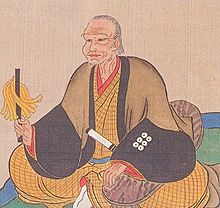- Sanada Masayuki
-
In this Japanese name, the family name is "Sanada".
Sanada Masayuki 
Sanada Masayuki Lord of Ueda In office
1585–1600Preceded by Sanada Yukitaka Succeeded by Sanada Nobuyuki Personal details Born 1547 Died July 13, 1611 Nationality Japanese Sanada Masayuki (真田 昌幸, 1544 (1547?) – July 13, 1611) was a Japanese Sengoku period daimyo. He was the third son of Sanada Yukitaka, a vassal daimyo to the Takeda family in Shinano province. He is known as a master strategist. Sanada Nobuyuki and Sanada Yukimura were his sons.
Contents
Biography
Initially, Masayuki changed his name to Mutō Kihei to inherit the Mutō clan, a branch of the Takeda family. He was favoured by Takeda Shingen, who discovered his talent at a young age and of whom Masayuki became a close servant. After Shingen's death, he continued to serve Takeda Katsuyori. However, during the Battle of Nagashino of 1575, both of Masayuki's elder brothers, Nobutsuna and Masateru, were killed. Masayuki changed his name back to Sanada so that he could claim his inheritance.
In 1577, immediately after Uesugi Kenshin's death, Masayuki took advantage of the internal turmoil within the Uesugi clan and seized Numata Castle in Kozuke province, an act that first demonstrated his strategic abilities.
After the fall of the Takeda clan in 1582, Masayuki temporarily yielded to Oda Nobunaga. However, Nobunaga died within a year at the Incident at Honnō-ji. Upon Nobunaga's death, the Sanada clan was left alone in Shinano province surrounded by hostile powers such as the Uesugi clan, the Hōjō clan, and the Tokugawa clan. By drifting through temporary alliances and fickle allegiances, the Sanada clan managed to survive.
In 1585, the Sanada clan stood opposed to Tokugawa Ieyasu. With 7,000 men, the Tokugawa forces lay siege to Ueda Castle, which was defended by only 2,000 soldiers. However, Masayuki was able to inflict 3,000 casualties on Tokugawa and won an overwhelming victory. This was the First Battle of Ueda Castle, a victory that earned Masayuki national prominence.
In 1589, Sanada retainers had disputes with the Hōjō clan, which eventually led to the fall of the Hōjō clan by Toyotomi Hideyoshi's invading armies.
After Hideyoshi's death, in 1600, Masayuki joined Ishida Mitsunari's side during the Battle of Sekigahara. Masayuki sent his eldest son, Nobuyuki, to the eastern side, while Masayuki and his younger son, Yukimura, fought on the western side, a move that ensured the Sanada clan's survival. Fortifying Ueda Castle, Masayuki fought against Tokugawa Hidetada's 38,000 men with only 2,000 soldiers. This was the Second Battle of Ueda Castle, and, whilst it was not exactly a victory, Masayuki was able to deliver a heavy blow to Hidetada and delay his forces for long enough that they were unable to show up at the main battlefield on time.
However, the western side, led by Ishida Mitsunari, lost the main battle, and the victorious Tokugawa Ieyasu was able to redistribute fiefs at will. Masayuki and Yukimura were initially going to be executed, but, given Nobuyuki's participation in the eastern army, they were instead exiled to Kudoyama in Kii province. The Sanada clan was inherited by Sanada Nobuyuki.
Sanada Masayuki died in Kudoyama in 1611.
Legacy
Even though Masayuki was never able to expand his territories as well as other daimyo, he is nevertheless often considered a talented daimyo, doomed by misfortune and the inconvenient terrains which surrounded his home domain. Toyotomi Hideyoshi had called Masayuki a person whose inside did not match his outside, that his allegiance was fickle and not to be trusted. Nevertheless, it was exactly his drifting alliances that helped the Sanada clan survive the onslaught of hostile clans, and, since the Edo period, he has been more extolled than vilified.
In popular culture
See People of the Sengoku period in popular culture.
See also
References
- Sansom, George (1961). "A History of Japan: 1334–1615." Stanford, California: Stanford University Press. p. 325.
- Turnbull, Stephen (1998). 'The Samurai Sourcebook'. London: Cassell & Co. p. 76.
Preceded by
noneLord of Ueda
1585–1600Succeeded by
Sanada NobuyukiCategories:- 1540s births
- 1611 deaths
- Daimyo
- Sanada clan
Wikimedia Foundation. 2010.
